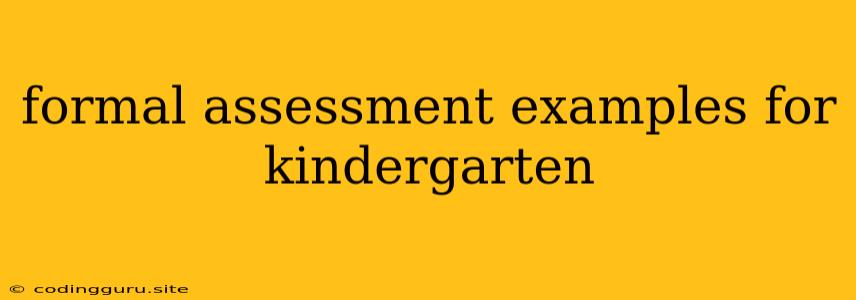Formal Assessment Examples for Kindergarten: A Guide for Teachers
As a kindergarten teacher, it's essential to assess your students' progress throughout the year. While informal assessments are valuable for daily observations, formal assessments provide a structured way to measure learning and identify areas for improvement. These assessments are usually standardized and can be used to track growth over time.
But what exactly are formal assessment examples for kindergarten? And how can they be used effectively in the classroom? This article will explore some common types of formal assessments used in kindergarten, providing examples and tips for implementation.
What are Formal Assessments in Kindergarten?
Formal assessments are structured tools that measure a student's knowledge, skills, and abilities. Unlike informal assessments, they are typically standardized and administered in a controlled environment. This means that all students take the same assessment under the same conditions, allowing for consistent comparison of results.
In kindergarten, formal assessments often focus on assessing fundamental skills like:
- Literacy: Reading readiness, letter recognition, phonemic awareness, and early writing skills.
- Math: Number sense, counting, basic addition and subtraction, shape recognition, and spatial reasoning.
- Social-Emotional Development: Self-regulation, social skills, emotional awareness, and problem-solving.
Examples of Formal Assessments in Kindergarten
Here are some common formal assessment examples for kindergarten:
1. Standardized Achievement Tests:
- Examples: The Iowa Assessments, Woodcock-Johnson Tests of Achievement, and the Wechsler Individual Achievement Test (WIAT).
- Purpose: These tests measure a student's overall academic achievement in various areas, including reading, math, and language. They are often administered at the beginning and end of the year to track progress.
- How to use them: Use the results to identify strengths and weaknesses, plan differentiated instruction, and communicate with parents about their child's academic progress.
2. Curriculum-Based Assessments:
- Examples: Running records, phonemic awareness tests, and math fact fluency assessments.
- Purpose: These assessments are designed to assess specific skills taught in the curriculum. They are often administered periodically throughout the year to monitor student learning.
- How to use them: Use the results to adjust instruction, provide extra support for struggling students, and celebrate student successes.
3. Portfolio Assessments:
- Examples: Collecting student work samples (writing, drawings, projects, etc.), documenting student progress over time, and reflecting on growth.
- Purpose: This type of assessment provides a holistic view of a student's learning. It helps teachers understand how students are developing their skills and how they think and learn.
- How to use them: Use portfolios to showcase student progress, demonstrate learning, and engage students in self-reflection.
4. Observation Checklists:
- Examples: Pre-designed checklists that teachers use to observe specific skills or behaviors during play, classroom activities, or individual interactions.
- Purpose: These checklists provide a structured way to observe student behavior and assess their progress in specific areas, such as social-emotional development or fine motor skills.
- How to use them: Use checklists to gather data on student performance, document progress, and identify areas for further development.
5. Teacher-Created Assessments:
- Examples: Projects, presentations, performance tasks, and writing samples.
- Purpose: These assessments are designed by teachers to measure student understanding and application of specific concepts. They provide flexibility and allow for tailored assessments based on the unique learning goals of each student.
- How to use them: Use teacher-created assessments to assess higher-level thinking skills, creativity, and problem-solving abilities.
Tips for Using Formal Assessments Effectively
- Choose the right assessments: Select assessments that are appropriate for your students' developmental level and aligned with your curriculum.
- Administer assessments appropriately: Follow the guidelines provided by the assessment creator for administration and scoring.
- Interpret results accurately: Understand the meaning of the results and use them to inform your teaching decisions.
- Communicate with parents: Share assessment results with parents and discuss their child's progress.
- Use assessments to guide instruction: Adjust your teaching strategies based on student strengths and areas for growth.
Conclusion
Formal assessments play a crucial role in the kindergarten classroom. By using a variety of assessments, teachers can accurately measure student progress, identify areas for improvement, and provide targeted instruction to meet the unique needs of each learner. Remember that assessments are not just about assigning grades. They are valuable tools that can help teachers understand their students better and guide them towards a successful educational journey.
